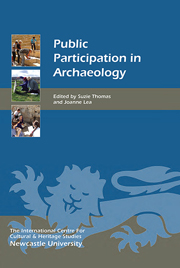Book contents
- Frontmatter
- Dedication
- Contents
- List of Illustrations
- Acknowledgments
- List of Abbreviations
- Preface
- Introduction
- Public Participation in Archaeology: International Models
- Public Participation in Archaeology Through Education
- Public Participation in Archaeology Through Tourism
- Public Participation in Archaeology Through Site Management and conservation
- 13 ‘They are hiding it … Why do they hide it? From whom, and for whom?’ Community Heritage at Work in the Post-Colonial Context of Jordan
- 14 Site Management in Turkey
- 15 Adopt a Monument: Social Meaning from Community Archaeology
- 16 Public Archaeology in canada
- List of Contributors
- Index
15 - Adopt a Monument: Social Meaning from Community Archaeology
from Public Participation in Archaeology Through Site Management and conservation
Published online by Cambridge University Press: 05 August 2014
- Frontmatter
- Dedication
- Contents
- List of Illustrations
- Acknowledgments
- List of Abbreviations
- Preface
- Introduction
- Public Participation in Archaeology: International Models
- Public Participation in Archaeology Through Education
- Public Participation in Archaeology Through Tourism
- Public Participation in Archaeology Through Site Management and conservation
- 13 ‘They are hiding it … Why do they hide it? From whom, and for whom?’ Community Heritage at Work in the Post-Colonial Context of Jordan
- 14 Site Management in Turkey
- 15 Adopt a Monument: Social Meaning from Community Archaeology
- 16 Public Archaeology in canada
- List of Contributors
- Index
Summary
The social significance of archaeology is an issue that has attracted a great deal of attention in archaeological circles in recent years. At a time when the world is becoming increasingly technological and constructed, it seems that both history and archaeology are gaining importance in the experiential sphere. According to the German journalist and archaeological writer Dieter Kapff, people no longer seek information or training as part of an all-round education; instead, the main motivation is to be entertained (Kapff 2004). Regardless of one's views on this matter, it is certain that archaeology has great entertainment value (Holtorf 2007). The great legends of humanity and our fascination with the distant past are exploited in popular movies, books and games. But does the social significance of archaeology primarily reside in entertainment and an escape from reality, or does it have a deeper meaning for people? The entertainment value of archaeology most likely derives from excitement, strangeness (otherness) and exoticism. However, these are not the best qualities for an understanding of our cultural heritage. The particular losers are sites of lesser prominence than a Stonehenge or a Pompeii.
If people no longer want to be educated, it may be because they no longer have the time or energy after the hectic world of work. In any case, to provide this education would perhaps require of archaeologists greater sensitivity, perceptiveness and new skills for communicating with larger audiences. Many archaeologists have had to relinquish their scientifically orthodox attitude and approach when dealing with the public.
- Type
- Chapter
- Information
- Public Participation in Archaeology , pp. 175 - 182Publisher: Boydell & BrewerPrint publication year: 2014

